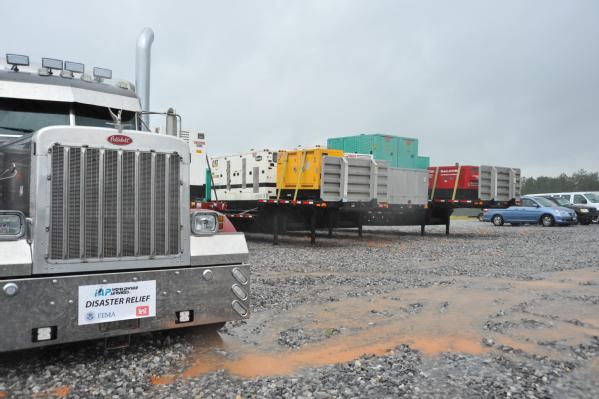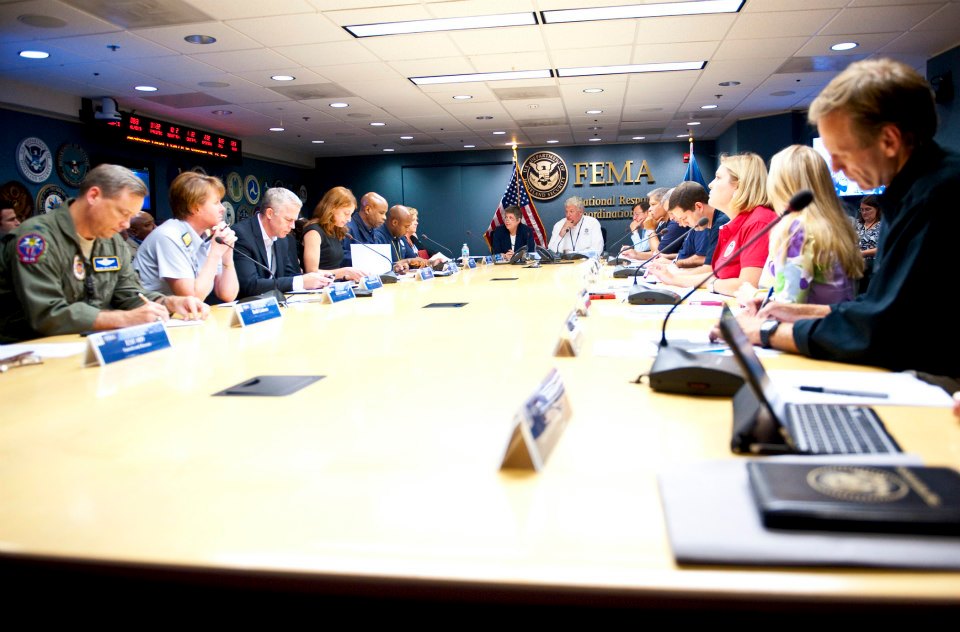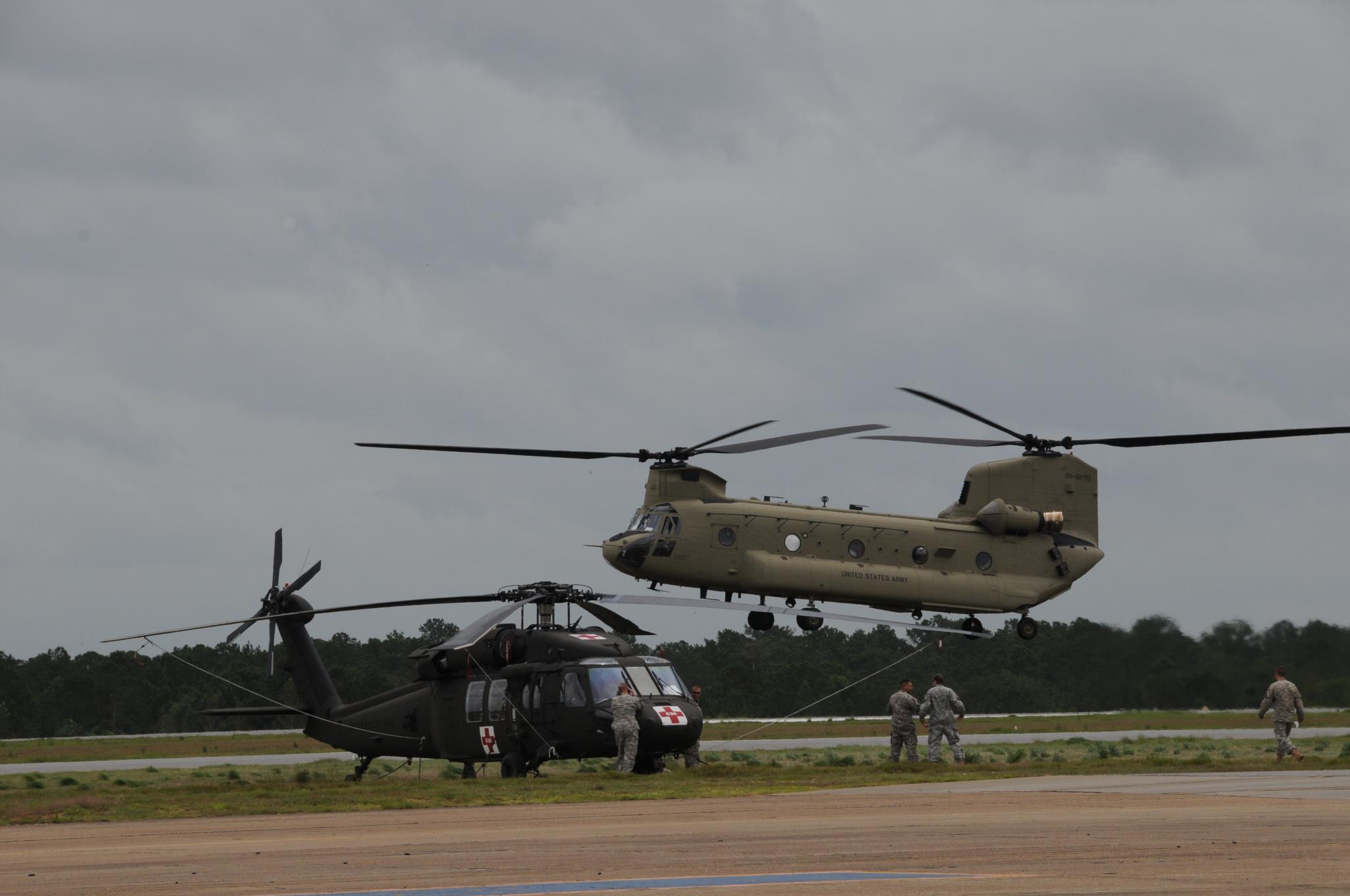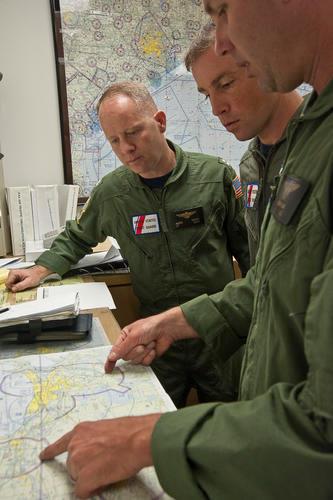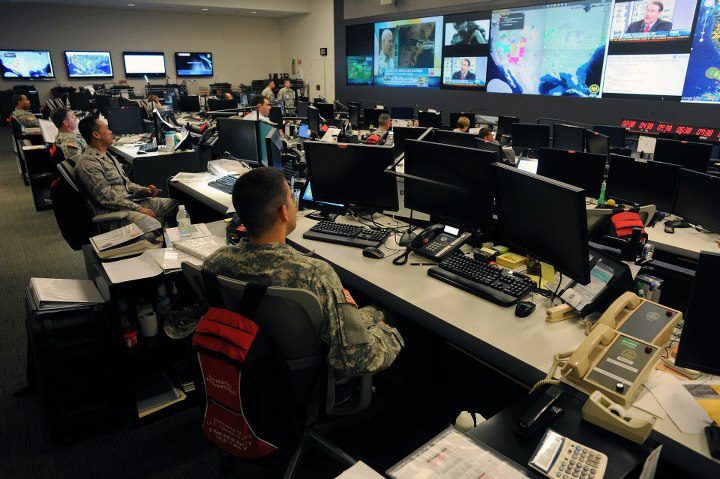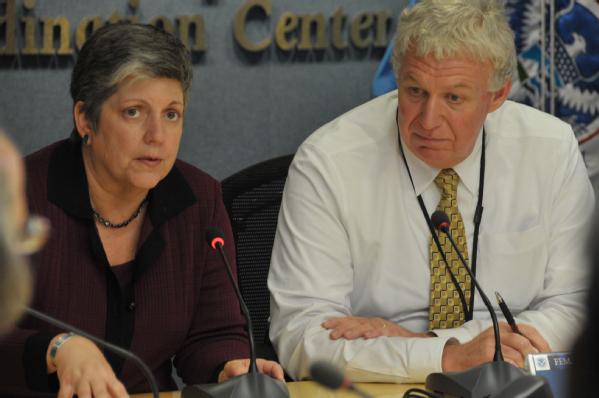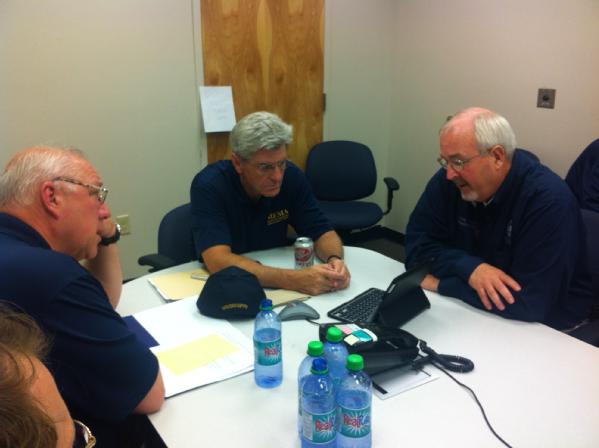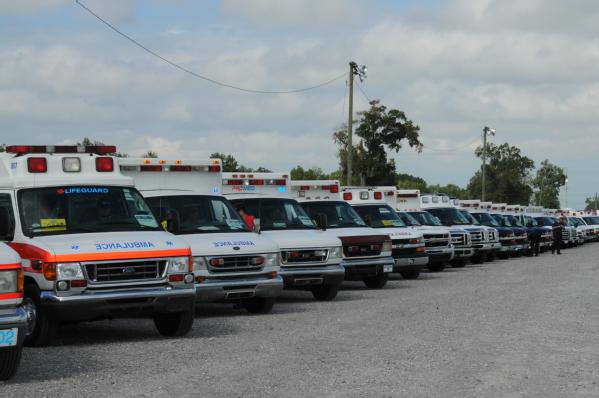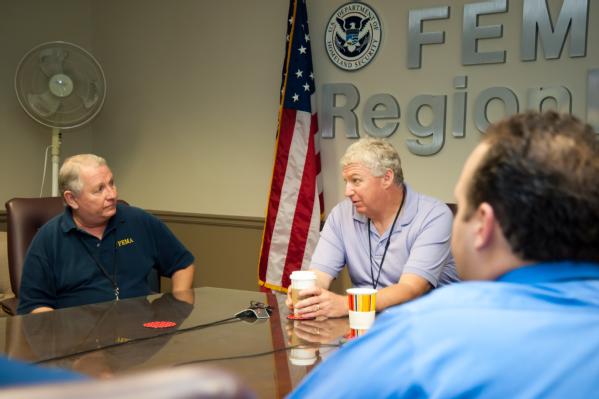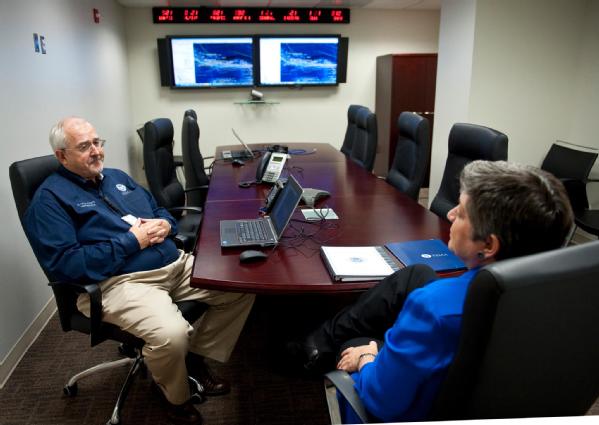Isaac update 7: August 31 recap
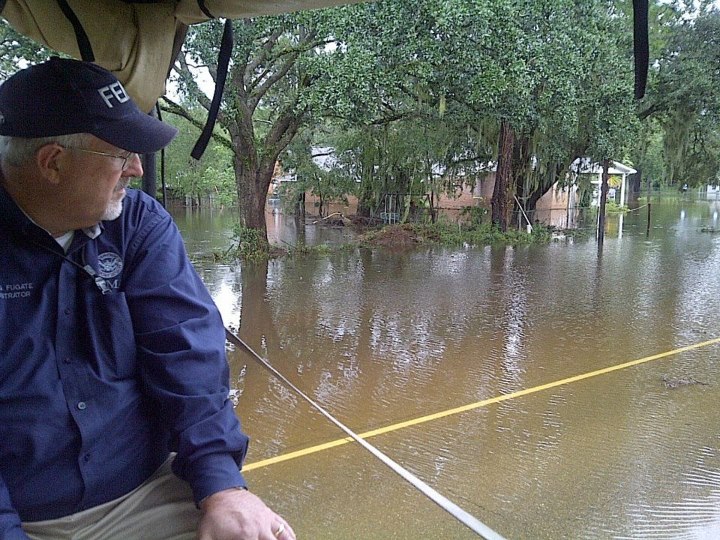
(August 30 - FEMA Administrator Craig Fugate surveys flooding in Madisonville, La. with Louisiana Governor Bobby Jindal. (Photo courtesy of Louisiana Governor's Office of Homeland Security and Emergency Preparedness)
Earlier today, the President held a call with a number of Parish Presidents, Mayors, and County Leaders from Louisiana and Mississippi let them know that they and their communities were in his thoughts and prayers and make clear that he had directed FEMA to continue to make all resources available. The President plans to visit Louisiana on Monday to meet with local officials and view ongoing response and recovery efforts to Hurricane Isaac, and Secretary of the Department of Homeland Security (DHS) Janet Napolitano will travel to Mississippi and Louisiana on Sunday, Sept. 2.
FEMA Administrator Craig Fugate was on the ground in Louisiana and met with U.S. Senator Mary Landrieu and Plaquemines Parish President Billy Nungesser today to discuss FEMA's efforts to support response and recovery in Louisiana following Hurricane Isaac. Administrator Fugate then traveled to the Mississippi Gulf Coast to meet with Mississippi Emergency Management Agency Director Robert Latham and other state and local officials and see firsthand the impact and the response efforts.
As Isaac continues inland and rivers continue to rise in some areas, FEMA urges individuals in affected areas, and areas expected to be affected, to monitor their NOAA Weather Radios and their local news for severe weather updates and warnings throughout the Labor Day weekend. Always follow the instructions of state, local, and tribal officials, especially urgent evacuations orders and flash flood warnings.
Joint federal, state and local disaster assessments are underway in Florida and are scheduled to begin, safety permitting, in Louisiana and Mississippi. Plans are being made for assessments in other areas, as they become accessible. These assessments identify the damages in impacted counties to help the governor determine if additional federal support will be requested.
In support of Louisiana, FEMA recently transferred more than 500,000 liters of water, 390,000 meals, 50,000 blankets, 30,000 cots and 3,500 tarps to the State of Louisiana for the state to distribute to individuals at Points of Distribution (POD) sites. The state, in coordination with local governments, identifies the location of these PODs which are currently operating across a number of parishes. Individuals should contact their local emergency management for more information.
On Wednesday, President Obama signed major disaster declarations for the states of Louisiana and Mississippi, making federal aid available to supplement state and local response efforts for emergency protective measures and debris removal in the areas affected by Hurricane Isaac beginning on August 26, 2012. These declarations build upon emergency declarations issued for both states earlier this week. Statewide hazard mitigation is available to all counties and tribal governments in Mississippi, and to all parishes and tribal governments in Louisiana.
Today, FEMA announced an amendment to the major disaster declaration for the State of Louisiana to include the Individual Assistance Program. Federal funding is available to affected individuals in Jefferson, Plaquemines, St. Bernard, St. John the Baptist, and St. Tammany parishes. Assistance can include grants for temporary housing and home repairs, low-cost loans to cover and uninsured property losses, and other programs to help individuals and business owners households recover from the effects of the disaster.
Individuals and business owners households who sustained losses in the designated parishes can begin applying for assistance tomorrow by registering online at http://www.disasterassistance.gov, or by web enabled mobile device at m.fema.gov. If you do not have access to the internet, you can call 1-800-621-FEMA(3362). Survivors who have a speech disability or hearing loss and use TTY should call 1-800-462-7585 directly; for those who use 711 or Video Relay Service (VRS), call 1-800-621-3362. The toll-free telephone numbers will operate, starting tomorrow, from 7 a.m. to 10 p.m. (local time) seven days a week until further notice.
The U.S. Army Corps of Engineers (USACE) has been closely working with the states of Louisiana and Mississippi. Teams are on the ground providing technical assistance, such as hydraulic modeling and finding available portable pumps, to reduce flooding along the Tangipahoa River and in Plaquemines Parish in Louisiana. USACE also deployed emergency power teams to Mississippi and Louisiana, and commodities, debris and temporary roofing teams are deployed to Louisiana.
The U.S. Department of Health and Human Service (HHS) has two Disaster Medical Assistance Teams, an Incident Response Coordination Team, and equipment on scene in Baton Rouge and New Orleans. The U.S. Department of Veterans Affairs is providing personnel and liaisons to support staffing of the Federal Medical Stations (FMSs). Two FMS caches have arrived in New Orleans and Baton Rouge.
A 24/7 Disaster Distress Helpline was activated by the HHS Substance Abuse and Mental Health Services Administration as a resource to people seeking crisis counseling after experiencing a natural or manmade disaster or tragedy. The residents of the Gulf States can call 1-800-985-5990 for assistance.
Incident Management Assistance Teams are in state emergency operations centers in Mississippi and Louisiana as well as supporting state and local needs in Plaquemines Parish, La. Mobile Emergency Response Teams also are deployed to Louisiana and Mississippi to support state emergency communications requirements including voice, video and information services.
While Isaac has been downgraded to a tropical depression, it still poses an ongoing threat for some areas. According to NOAA's National Weather Service, a flood risk continues for low-lying areas in communities in northern Louisiana, northern Mississippi, and the states of Arkansas, Missouri, Illinois, and Indiana during the next five days. Flash flood watches and warnings are currently in effect for portions of Arkansas and northern Louisiana. The National Weather Service is the official source for weather information.
As the storm continues to move further inland, FEMA's regional offices in Denton, Texas, Chicago, Ill., and Kansas City, Mo. are monitoring Tropical Depression Isaac, and remain in close coordination with potentially affected states. An Incident Management Assistance Team and a Mobile Emergency Response Support Team from a previous disaster are on the ground in Ohio and can support response efforts for the approaching storm, if needed.
Below is a timeline of some of the key activities and events that have occurred since Tropical Depression Isaac first threatened Puerto Rico and the U.S. Virgin Islands on its path to the Gulf of Mexico:
Friday, August 31, 2012
- Department of Homeland Security Secretary Janet Napolitano joined FEMA Administrator Craig Fugate on a video-teleconference call today to discuss the latest developments with the National Weather Service, partner agencies and regional representatives to assess their needs and readiness. The conference had the participation of emergency management leadership from the affected states including Florida, Alabama, Mississippi, Louisiana, and Texas.
- FEMA Federal Coordinating Officers remain on the ground in Mississippi and Louisiana, working closely with state and local officials to provide the full resources of the federal government to support response efforts to protect lives and property.
- FEMA and the U.S. Small Business Administration participated in joint federal, state and local preliminary damage assessments are on the ground in Palm Beach and Indian River counties in Florida. These assessments identify the damages in impacted counties to help the governor determine if additional federal support will be requested.
- FEMA transferred to the state of Louisiana more than 500,000 liters of water, 390,000 meals, 50,000 blankets, 30,000 cots and 3,500 tarps for distribution. The Louisiana National Guard opened Points of Distribution (POD) sites, to provide food, water, and supplies to those affected by Isaac. These locations are determined by the state and local governments.
- National Tribal Assistance Coordination Group (TAC-G) hosted a conference call with to discuss Isaac's impact, receive updates from Tribes, share initial reports from TAC-G partners regarding Isaac and future planning. The coordination group counts with the participation of Department of Interior/Bureau of Indian Affairs, Department of Health and Human Services Office of Indian Health Service, Department of Homeland Security, National Congress for American Indians and United Southern and Eastern Tribes.
- U.S. Postal Service offices were open and mail delivery returned today to New Orleans, Baton Rouge, Lafayette and surrounding postal facilities where Isaac's torrential rains, severe winds and flooding had forced offices to close. Today's mail consisted of Social Security checks, medicine and mail that could not be delivered on Tuesday. Posts Offices are open and mail delivery has resumed throughout Mississippi. Customers with questions or concerns about their mail should call 1-800-ASK-USPS (1-800-275-8777).
- The U.S. Coast Guard, Army Corps of Engineers, River Pilot Associations and port authorities surveyed the Mississippi River and surrounding waterways in an aggressive effort to identify navigational hazards. Although the Mississippi River was heavily impacted by the storm, the navigational channel is in good condition. The Coast Guard is working with the maritime industry to respond to a number of ship groundings and barge standings' along the riverbank caused by the river surge and high winds of the storm.
- U.S. Army Corps of Engineers (USACE) continues to support the states of Alabama, Mississippi and Louisiana Emergency Operation Centers and FEMA Regions IV and VI Regional Response Coordination Centers. USACE is operating the Greater New Orleans District Hurricane and Storm Damage Risk Reduction System (HSDRRS) and has begun opening up major structures as the storm surge slowly subsides. Major structures will continue to be opened until all required openings are completed. In Mississippi, USACE is assisting Mississippi state officials with a controlled release at the non-federal dam on the Tangipahoa Lake in Percy Quin State Park in order to relieve pressure on the dam. The Vicksburg District Corps of Engineers created inundation mapping and provided the pumps to assist in relieving pressure on the dam.
- More than 4,100 National Guard forces in Alabama, Mississippi, Florida and Louisiana are on State Active Duty prepared to respond to Isaac.
- FEMA and the U.S. Small Business Administration staff joined state and local officials on joint preliminary damage assessments (PDA) in Florida. These assessments identify the damages in impacted counties and to help the governor determine if additional federal support will be requested.
- FEMA's regional offices in Denton, Texas, Chicago, Ill., and Kansas City, Mo. continue to monitor Tropical Depression Isaac, and remain in close coordination with potentially affected states. Regional Incident Management Assistance teams and other staff are on standby. There is also an Incident Management Assistance Team and Mobile Emergency Response Support team, on the ground in Ohio, from a previous disaster that can support response operations from storm, if needed.
- U.S. Department of Energy (DOE) has agreed to lend 1 million barrels of sweet crude oil from the Strategic Petroleum Reserve's (SPR) Bayou Choctaw site in Louisiana to Marathon Petroleum Company to address the short term impact on the company's refining capacity caused by Hurricane Isaac. The loan will be provided under short-term contractual agreements and Marathon Petroleum Company will return an equal amount of similar quality oil to the Reserve within three months, plus premium barrels, which is similar to interest.
- The American Society for Prevention of Cruelty of Animals (ASPCA) is working with the Louisiana State Animal Response Team to plan and complete animal rescues. As part of this effort, ASPCA is deploying responders to conduct door-to-door rescue of animals in flooded or abandoned homes, assisting a Louisiana animal shelter facing flooding, and supplying boats and other equipment for critical water rescue missions. More information is available at. www.aspca.org
Previous daily recaps:



